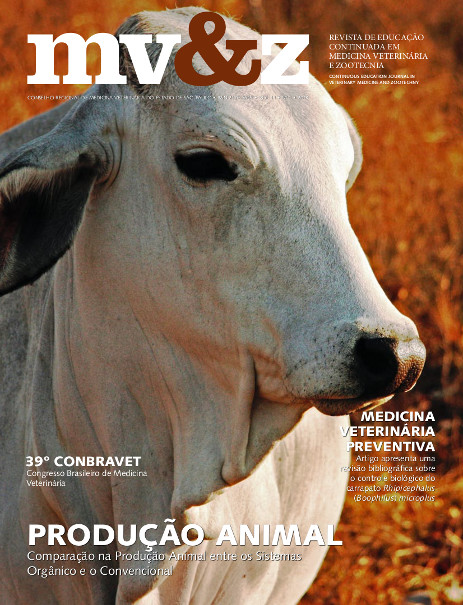Seroprevalence of rabies virus in wild carnivores
Main Article Content
Abstract
All mammals are susceptible to rabies virus, especially those of the order Carnivora and Chiroptera. In the wild cycle animals that act as reservoirs vary according to region. In Latin America, the bats act as main reservoirs of the virus in the wild cycle, however the rabies virus has been isolated from other wildlife species such Cerdocyon thous (Crabeating Fox), Procyon cancrivorus (Crab-eating Raccoon), and Callithrix jacchus jacchus (Common marmose). In this context, this work aimed to analyze the seroprevalence for rabies virus in 9 carnivores captured in areas of large and small forest fragments in the rural area in central west region of São Paulo state. Were captured 4 Nasua nasua (Coati), 4 Cerdocyon thous (Crab-eating Fox) and a Leopardus pardalis (Ocelot), with the use of Tomahawk traps containing chicken leg as bait. They were anesthetized with Zoletil® (Tiletamine and Zolazepam) and had blood samples collected by jugular vein puncture. The blood was placed in collecting tube without EDTA, and serum in microtube. Sera samples were stored at -20°C and than were tested for neutralization in cell culture for the determination of neutralizing antibodies to rabies virus by rapid method focus inhibition of fluorescence (RIFFT). In Cerdocyon thous, that is considered as an important reservoir for a particular rabies virus variant in Brazil, 75% showed antirabies antibodies titers above 0,5 UI/mL. These data suggests that rabies virus is presented in the analyzed region and somehow these wildlife species get in contact with rabies virus. It’s important to note that these animals were captured in a region of close contact with other humans and domestic animals, representing a possible epidemiological risk.
Article Details
1. Autores mantém os direitos autorais e concedem à revista o direito de primeira publicação, com o trabalho licenciado sob a Creative Commons Atribuição-NãoComercial-SemDerivações 4.0 Internacional
2. Autores têm autorização para assumir contratos adicionais separadamente, para distribuição não-exclusica da versão do trabalho publicada nesta revista (ex.: publicar em repositório institucional ou como capítulo de livro), com reconhecimento de autoria e publicação inicial nesta revista.
3. Autores têm permissão e são estimulados a publicar e distribuir seu trabalho online (ex.: em repositórios instituicionais ou na sua página pessoal) a qualquer ponto antes ou durante o processo editorial, já que isso pode gerar alterações produtivas, bem como aumentar o impacto e a citação do trabalho publicado (Veja O Efeito do Acesso Livre);
